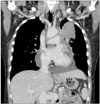Abstract
Ovarian cancer is generally primary cancer and less frequently originates from metastasis from non-gynecological cancer. Ovarian metastasis from lung cancer represents only 2~4% of all ovarian metastatic cancers. We report a case of ovarian metastasis of non-small cell lung cancer with epidermal growth factor receptor mutation. The patient underwent cytoreductive surgery for the ovarian mass and erlotinib therapy for the metastatic lung cancer. Erlotinib therapy markedly decreased the size of lung mass.
Figures and Tables
 | Fig. 1Abdomen and pelvis computed tomography. A 14.7×13.4 cm sized huge tumor of right ovary and peritoneal carcinomatosis are noted. |
 | Fig. 2Chest computed tomography. It reveals a 10×6 cm sized huge mass in left upper lung and massive right sided pleural effusion. |
 | Fig. 3Images taken after 2 cycles of gemcitabine with carboplatin chemotherapy. (A) Abdomen and pelvis computed tomography (CT) reveals increasing the size of left ovarian mass (20×14.5 cm). (B) Chest CT reveals increasing the size of left upper lung mass (12×8.2 cm). |
References
1. Hart W. Diagnostic challenge of secondary (metastatic) ovarian tumors simulating primary endometrioid and mucinous neoplasms. Pathol Int. 2005; 55:231–243.
2. Horn L, Pao W, Johnson D. Neoplasm of the Lung. In : Longo D, Fauci A, Kasper D, Hauser S, Jameson J, Loscalzo J, editors. Harrison's principles of internal medicine. 18th ed. New York: McGraw Hill;2012. p. 745–750.
3. Schiller J, Harrington D, Belani C, Langer C, Sandler A, Krook J, et al. Comparison of four chemotherapy regimens for advanced non-small-cell lung cancer. N Engl J Med. 2002; 346:92–98.
4. Lynch T, Bell D, Sordella R, Gurubhagavatula S, Okimoto R, Brannigan B, et al. Activating mutations in the epidermal growth factor receptor underlying responsiveness of non-small-cell lung cancer to gefetinib. N Engl J Med. 2004; 350:2129–2139.
5. Fader A, Rose P. Role of surgery in ovarian carcinoma. J Clin Oncol. 2007; 25:2873–2883.
6. Jung YE, Lee JW, Kim BG, Bae DS. Ovarian metastasis from pulmonary adenocarcinoma. Obstet Gynecol Sci. 2013; 56:341–344.
7. Varadhachary G, Abbruzzese J. Carcinoma of Unknown Primary. In : Longo D, Fauci A, Kasper D, Hauser S, Jameson J, Loscalzo J, editors. Harrison's principles of internal medicine. 18th ed. New York: McGraw Hill;2012. p. 822–823.
8. Pfister D, Johnson D, Azzoli C, Sause W, Smith T, Baker S, et al. American society of clinical oncology treatment of unresectable non-small-cell lung cancer guideline: update 2003. J Clin Oncol. 2004; 22:330–353.
9. Hirsch F, Varella-Garcia M, Bunn P Jr, Franklin W, Dziadziuszko R, Thatcher N, et al. Molecular predictors of outcome with gefetinib in a phase III placebo-controlled study in advanced nonsmall-cell lung cancer. J Clin Oncol. 2006; 24:5034–5042.
10. Sequist L, Bell D, Lynch T, Haber D. Molecular predictors of response to epidermal growth factor receptor antagonists in nonsmall-cell lung cancer. J Clin Oncol. 2007; 25:587–595.




 PDF
PDF ePub
ePub Citation
Citation Print
Print




 XML Download
XML Download